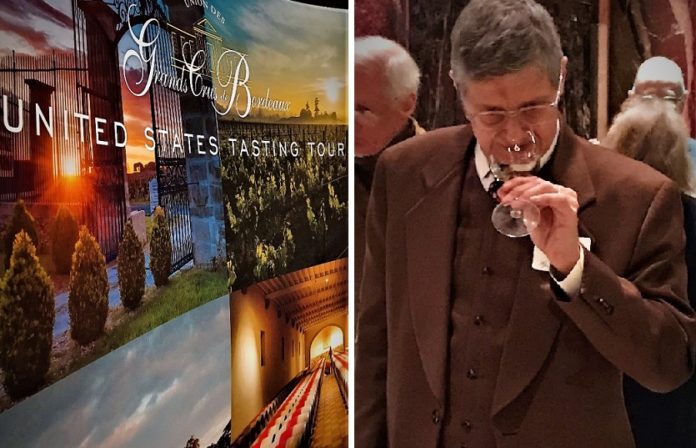
The correct answer is Bordeaux 2016
Do you know the best French wine and the 2nd best destination in France? If you said Bordeaux – you would be correct! Not only are the wines of Bordeaux among the best on the planet, the city is the second most popular destination in France (Paris takes first place).
At this time, there are approximately 7500 different chateaux in Bordeaux, covering over 120,000 hectares or 296,596 acres of grapevines planted in 60 different appellations, producing almost 900 million bottles of wine per vintage.
eTN Chatroom: Discuss with readers from around the world:
The Difference Between Left and Right
Left Bank.
The First Growth Bordeaux, plus the other 1855 Classified Bordeaux wines of the Medoc, including the 2nd, 3rd, 4th and 5th Growths are from the Left Bank. This is the location for 200+ chateaux that are classified as Cru Bourgeois. Wine was produced in the region for thousands of years, but thanks to the Romans, wine cultivation started in earnest in the 18th century. The area has natural drainage, access to water from the Atlantic Ocean and the Gironde River and the terroir features gentle slopes with a mix of gravel, stones, sand, limestone and clay soils. Recognizable names include: Mouton Rothschild, Haut-Brion and Laffite. Left Bank AOCs include: Medoc, Graves, St. Estephe, Pauillac, St. Julien, and Sauternes (elegant white dessert wines).
The Left Bank is noted for its Cabernet Sauvignon that ages well, taking on notes of tobacco, cigar box, earth and forests and frequently described as tannic, masculine and likely to be expensive.
A nearby appellation is Pessac Leognan previously known as Graves (prior to 1987). The soils produce excellent elegant, refined and perfumed wines from the gravel-based soils. The appellation is also known for dry white Bordeaux, mostly Sauvignon Blanc and Semillon.
Right Bank.
Right Bank wines are noted as being opulent, silky, rich and decadent. Right Bank vineyards are frequently closer to an average of 5 hectares in size and family homes. Noted wine producers include Pomerol and Saint Emilion.
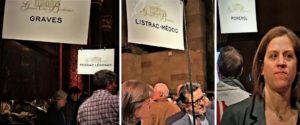
Merlot is the most popular grape cultivated on the Right Bank, producing Cabernet Franc and Petit Verdot, Malbec and Cabernet Sauvignon. The results are softer, richer with less tannin. The terroir includes limestone, less gravel and more clay (preferred by Merlot). Right Bank AOCs include Pomerol (900 producers), St. Emilion, Margaux, Bourg and Blaye.
Grape Varieties
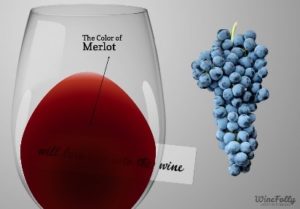
Merlot (may be derived from the French word merle meaning Blackbird). Aromas of plums, raspberries, fruit, spices, cigar box, chocolate, leather and smokiness from oak. Sixty percent of all plantings are Merlot. Easy to grow, this grape ripens earlier than Cabernet Sauvignon. Wines are delicious while young. Think Petrus, the most expensive Bordeaux wine, 100 percent Merlot.
Cabernet Sauvignon. Considered the King of Grapes. Second most planted grape varietal in Bordeaux. Blending partners include Merlot, Cabernet Franc, Petit Verdot. Aromas include blackcurrant, cassis, green bell pepper, tobacco, leather, meatiness and spices and smokiness from oak.
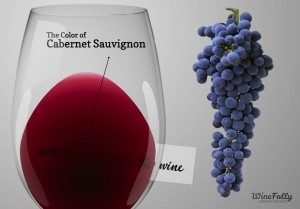
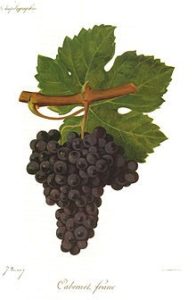
Cabernet Franc. Used as a blending partner with Merlot or Cabernet Sauvignon. Aromas of raspberry, plum, violet and leaves of black currants.
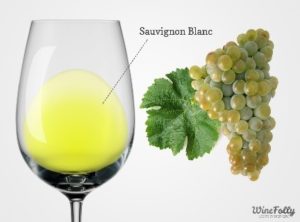
Sauvignon Blanc. Main grapes in the fresh, crispy Bordeaux Blanc. Might be blended with Semillon if the goal is a richer, full-bodied wine with some oak. Aromas include: elderflower, gooseberry, grapefruit and peach.
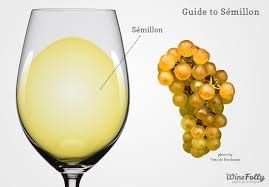
Semillon. The main grape for delicious sweet dessert wine that is dry barrel-fermented in Bordeaux. Honeyed and nutty flavors develop with ageing and blending with Sauvignon Blanc lightens and enlivens the experience.
Wine Notes. Curated from hundreds presented at the recent 2019 New York Grand Crus de Bordeaux
2016 Chateau La Louviere. 85 percent Sauvignon Blanc, 15 percent Semillon. Aged 10 months in 30 percent new barrels on full lees with batonnage (stirring settled lees back into wine).
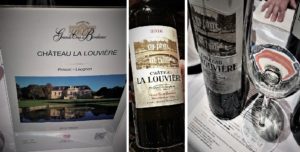
Canadians have enjoyed this wine since the 17th century. In the 18th century the wine could be found on Russian dining tables. La Louviere is considered among the finest dry white wines in the Graves and an excellent representation of the wines of the Pessac-Leognan appellation.
Wine Notes: Pale white blonde with golden sparkles to the eye. The nose finds unique flashes of grapefruit, and roses, plus peaches, limes and nectarines, honey and honeysuckle, citrus and tropical fruits with slightly pine and smoky notes. Well structured and balanced with a powerful statement of minerality on the palate. Long delicious aftertaste. Pair with steamed salmon, chicken or quiche.
2016 Chateau Langoa Barton. 57 percent Cabernet Sauvignon, 34 percent Merlot, 9 percent Cabernet Franc. Aged. 18 months; 60 percent new barrels.
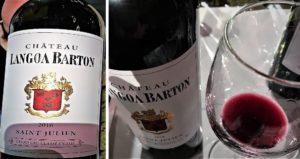
This chateau was purchased by Hugh Barton in 1821. The property has remained in the family ever since. Today Lilian Barton Satoris manages the properties and the wine merchant company. The vineyards are located to the south of the appellation Saint Julien and noted for its elegance, charm and finesse with subtle flavors.
Wine Notes: To the eye dark velvet ruby red trending to an almost luxurious black/purple. The nose finds old roses, wet earth and aged leather, expresso, herbs and spice. Full bodied, with tannins and vanilla enhancing the complexity of the taste experience. Perfect for a cold winter evening with roast beef.
2016 Chateau Franc Mayne. 90 percent Merlot, 10 percent Cabernet Franc. Aged 18 months; 60-80 percent new barrels. Soil: clay-limestone on the plateau and slope, clay-sand at the foot of the slope.
Appellation: Saint-Emilion Grand Cru
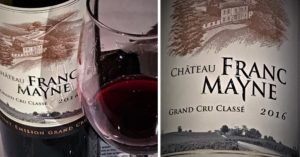
Recently purchased by Jean-Pierre Savare (Chairman of Oberthur Finance) and his family, the 7-hectare Chateau Franc Mayne is located on the St. Emilion plateau. It was previously owned by Griet Van Malderen and Herve Laviale (2005). Close to Beau-Sejour Becot or Grand Mayne, Franc Mayne’s soils are composed of limestone and clay-limestone slopes.
Wine Notes. Deep dark almost black/purple to the eye. The nose finds red fruit, oak, leather, wood and chocolate. Integrated firm tannins add complexity to the taste with hints of plums, herbs, raspberries and sweet spices adding to the delicious experience. All sensory points are delighted.
2016 Chateau Suduiraut Sauterne. 90 percent Semillon, 10 percent Sauvignon Blanc. 18-24 months barrel aged – 50 percent new barrels. Soil: clay-sand gravel. Classified as Premier Cru in 1855.
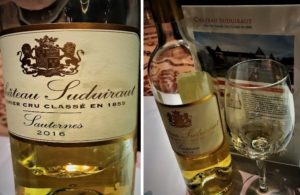
Chateau Suduiraut is known to be one of the finest Sauternes in the world based on choice of plots of vines, meticulous harvesting methods and quality control over fermentation in each individual barrel plus a drastic selection process when it is time to make the blend of the different wines. Elegance comes from a match of voluptuous texture, mineral freshness and heat of spices.
Wine Notes: Golden sunshine yellow to the eye (with age the bright gold evolves to a dark amber). The nose is delighted with honey, honeysuckle, and spicy cinnamon plus roasted almond and hazelnut. The palate is rewarded with honey, citrus and apricots, peaches and mango tempered by acidity.
2016 Chateau Lafaurie-Peyraguey. 93 percent Semillon, 6 percent Sauvignon Blanc, 1 percent Muscadelle. Barrel aged – 18 months- 40 percent in new barrels. Soil: Clay and gravel plus clay and sand.
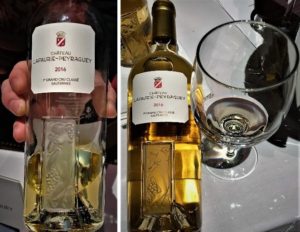
Owned by Silvio Denz, he combines his love of winemaking and luxury goods, incorporating Rene Lalique into the design of the bottle based on an engraving “Woman and Grapes” (September 1928). The 2016 vintage began with heavy rains in the spring before a warm and dry summer. The rainfall from September 13 allowed optimal maturation of the berries and ideal development of botrytis. The grape harvest started later than usual – September 29. The wine is produced from only 48 percent of 2016 production.
Wine Notes. Sunshine yellow in the glass with honey, yellow apples, kiwi, and yellow raisins to the nose. Soft and sensuous on the palate.
The Event: Grands Crus de Bordeaux @ Cipriani. 2019
Hundreds of wines buyers, sellers, caterers and restauranteurs, educators, writers and others turned out to experience the soon to be released wines of 2016 vintage wines of Bordeaux. The Union is an association of the best Bordeaux producers from all major Bordeaux growing regions. Over 90 chateaux participate, pouring over 100 wines from the highly-acclaimed 2016 vintage.



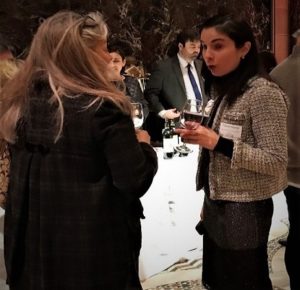
For additional information, visit ugcb.net.
© Dr. Elinor Garely. This copyright article, including photos, may not be reproduced without written permission from the author.
